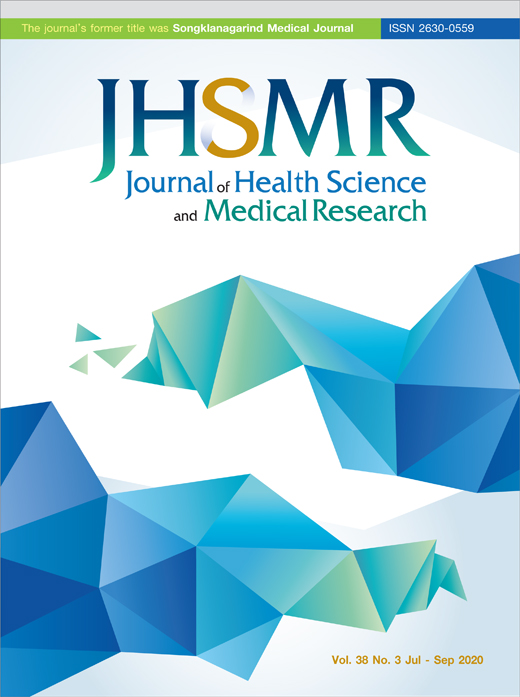Quality of Life and Burden of Lung Cancer Patients’ Caregivers: A Cross-Sectional Study from Southern Thailand
DOI:
https://doi.org/10.31584/jhsmr.2020736Keywords:
associated factors, caregivers, caregiver burden, lung cancer, quality of lifeAbstract
Objective: To measure the Quality of Life (QoL) and Caregiver Burden Scale (CBS) of lung cancer patients’ caregivers and assess the associated factors.
Material and Methods: This was a cross-sectional study. We interviewed lung cancer patients and their caregivers who were visiting the outpatient department of a tertiary hospital in Thailand. QoL was measured by the World Health Organization Quality of Life-BREF-THAI. CBS was measured by Zarit’s burden interview. The data were collected using the KoBoToolbox application. Multivariate ordinal logistic regression was used to assess associations between caregivers’ QoL and CBS with the dependent variables, including patient and caregiver factors.
Results: Two hundred and four patients and 202 caregivers were included in the study. The only caregivers factor associated with lower QoL was younger age [odds ratio (OR)=0.33, 95% confidence interval (CI): 0.11-0.95)] while factors associated with better QoL were income (OR=3.91, 95% CI: 1.13-14.50) and being a child of the patient (OR=3.24, 95% CI: 1.02-11.30). The main caregivers factor associated with a lower CBS was being Muslim (OR=0.16, 95% CI: 0.05-0.52), and the main factor associated with a higher CBS was income (OR=6.12, 95% CI: 1.66-23.75). The patients factors affecting CBS were female (OR=0.36, 95% CI: 0.17-0.71), Barthel’s activity daily living (ADL) index (OR= 7.42, 95% CI: 1.99-28.65), and ≥2 years looking after a patient (OR=0.40, 95% CI: 0.18-0.88).
Conclusion: The factors affecting caregivers’ QoL and CBS were their patients’ ADL and years with disease. Training on caring patients to maintain the patients’ ADL for caregivers should be provided. Health authorities should provide opportunities for patients to share their experience on how they live and cope with the symptoms of lung cancer.
References
2. Ministry of Public Health. Number and death rate per population 1994-2016 [homepage on the Internet]. Bangkok: Strategy and Planning Division; 2018 [cited 2018 Dec 14]. Available from: http://social.nesdb.go.th/SocialStat/Stat Report_Final.aspx?reportid=367&template=1R2C& yeartype=M&subcatid=15
3. International Agency for Research on Cancer. Lung fact sheet [homepage on the Internet]. Geneva: WHO; 2018 [cited 2018 Dec 14]. Available from: http://gco.iarc.fr/today/data/ factsheets/cancers/15-Lung-fact-sheet.pdf
4. Caring for the caregiver [homepage on the Internet]. Maryland: National Cancer Institute; 2017 [cited 2018 Dec 14]. Available from: https://www.cancer.gov/publications/ patient-education/caring-for-the-caregiver
5. LeSeure P, Chongkham-ang S. The experience of caregivers living with cancer patients: a systematic review and metasynthesis. J Pers Med 2015;5:406–39.
6. World Health Organization. WHOQOL: measuring quality of life [homepage on the Internet]. Geneva: WHO; 1999 [cited 2018 Dec 14]. Available from: https://www.who.int/ healthinfo/survey/whoqol-qualityoflife/en/
7. American Cancer Society. Treating non-small cell lung cancer [homepage on the Internet]. Atlanta: American Cancer Society; 2018 [cited 2018 Nov 23]. Available from: https:// www.cancer.org/cancer/non-small-cell-lung-cancer/ treating.html
8. Borges L, Franceschini J, Costa D, Fernandes G, Jamnik S, Santoro L. Family caregiver burden: the burden of caring for lung cancer patients according to the cancer stage and patient quality of life. J Bras Pneumol 2017;43:18–23.
9. Ben-Arye E, Samuels N. Patient-centered care in lung cancer: exploring the next milestones. Transl Lung Cancer Res 2015; 4:630-4.
10. Nazlı H, Nadiye O, Elanur Y, Nese E, Behice E. The quality of life of family caregivers of cancer patients in the East of Turkey. Eur J Oncol Nurs 2010;14:181-260
11. Minaya F, Berbis J, Chinot O, Auquier P. Assessing the quality of life among caregivers of patients with gliomas. Neurooncol Pract 2014;1:191-7.
12. Yu H, Li L, Liu C, Huang W, Zhou J, Fu W, et al. Factors associated with the quality of life of family caregivers for leukemia patients in China. Health Qual Life Outcomes 2017; 23:15-55.
13. Awadalla W, Ohaeri U, Gholoum A, Khalid A, Hamad A, Jacob A. Factors associated with quality of life of outpatients with breast cancer and gynecologic cancers and their family caregivers: a controlled study. BMC Cancer 2007;19:7-14.
14. Gholami A, Jahromi LM, Zarei E, Dehghan A. Application of WHOQOL-BREF in measuring quality of life in health-care staff. Int J Prev Med 2013;4:809–17.
15. World Health Organization. WHO | WHOQOL: measuring quality of life [homepage on the Internet]. Geneva: WHO; 1999 [cited 2018 Nov 23]. Available from: http://www.who. int/healthinfo/survey/whoqol-qualityoflife/en/?fbclid= IwAR29qL1Pf4VUAPCjH7Ju-zJbe4wa5WLRidi1zTKcALa_ HG4WuLXr1M4vXgU
16. Toonsiri C, Sunsern R, Lawang W. Development of the burden interview for caregivers of patients with chronic illness. J Nurs Educ 2011;4:62–75.
17. Tan Y, Molassiotis A, Lloyd Williams M, Yorke J. Burden, emotional distress and quality of life among informal caregivers of lung cancer patients: an exploratory study. Eur J Cancer Care (Engl) 2018;27:36-50.
18. Hu X, Peng X, Su Y, Huang W. Caregiver burden among Chinese family caregivers of patients with lung cancer: a cross-sectional survey. Eur J Oncol Nurs Off J Eur Oncol Nurs Soc 2018;37:74–80.
19. Kim Y, Baker F, Spillers RL. Cancer caregivers’ quality of life: effects of gender, relationship, and appraisal. J Pain Symptom Manage 2007;34:294–304.
20. Gangane N, Khairkar P, Hurtig K, Sebastián MS. Quality of life determinants in breast cancer patients in central rural India. Asian Pac J Cancer Prev APJCP 2017;18:3325–32.
21. Govina O, Kotronoulas G, Mystakidou K, Katsaragakis S, Vlachou E, Patiraki E. Effects of patient and personal demographic, clinical and psychosocial characteristics on the burden of family members caring for patients with advanced cancer in Greece. Eur J Oncol Nurs 2015;19:81–8.
22. Du J, Shao S, Jin H, Qian G, Xu W, Lu Q. Factors associated with health-related quality of life among family caregivers of disabled older adults: a cross-sectional study from Beijing. Eur J Cancer Care 2018;27:60-75.
23. Mosher E, Champion L, Azzoli G, Hanna N, Jalal I, Fakiris J, et al. Economic and social changes among distressed family caregivers of lung cancer patients. Support Care Cancer 2013;21:819–26.
























